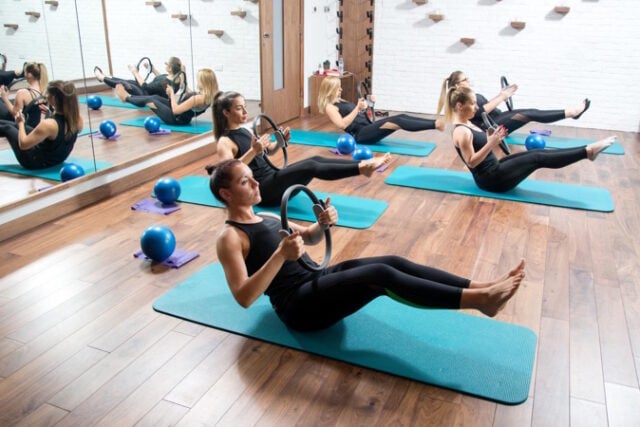
In today’s world, muscle tension is an everyday reality. Computer work, long hours spent sitting, stress, lack of sleep, and too little restorative movement keep our bodies in “survival mode.” Muscles tighten to compensate for poor postural patterns and protect overloaded structures—but over time they become the source of pain, stiffness, and limitation. The key to relief? Not more strength—but more awareness. And this is where Pilates comes in—not only as a strengthening tool, but also a profoundly releasing one.
In this article, we’ll show how Pilates—especially Pilates on the reformer—helps relax tight muscles, improve mobility, and restore harmony in the body. You’ll learn which techniques reduce tension, how Pilates equipment works, and why a Pilates reformer is one of the most effective tools for combating chronic muscular stress.
Why Does Muscle Tension Build Up?
Muscle tension doesn’t always come from intense effort or stress—much more often it’s the result of years of overload, poor posture, and lack of balance in everyday movement. A forward head posture, rounded shoulders, a rigid pelvis, and held breath—these are patterns we repeat daily, often unconsciously. Muscles—especially around the neck, shoulders, chest, and lower back—remain constantly tight, trying to compensate for a lack of deep core stability. In response to chronic overload, muscle fibres stiffen, shorten, and begin to limit natural range of motion. The result? A stiff neck, back pain, tension headaches, sciatica, the feeling of a “tight” body, and fatigue you can’t simply walk off. Worse yet—the longer it lasts, the harder it is to break free without targeted, intentional work with the body.
This is exactly where Pilates helps—as a method that addresses the root cause rather than masking symptoms. Instead of forceful stretching or isolated strengthening, Pilates focuses on mindful movement, deep core activation, and elongation—lengthening soft tissues while they remain active. This approach is key to reducing tension because it engages not only the muscular system but also the nervous system—teaching the body how to settle during movement and how to move without overload. Regular Pilates practice helps “unlearn” poor patterns and build new ones—more economical, balanced, and less taxing. Thanks to this, tension doesn’t disappear only briefly—it subsides for good—and the body learns to return to neutral even after a tough day. Whether you practice on the mat or choose Pilates on reformers, the key is this: not necessarily more movement, but better movement.
Reformer Pilates Combines Strength, Mobility, and Therapeutic Training
Reformer Pilates is a unique method that blends the qualities of strength, mobility, and therapeutic work—without the risk of overloading the body. Springs play a central role, providing controlled resistance while allowing fluidity of movement and a reduction in gravitational forces. In practice, this means you can strengthen and lengthen at the same time—without jerky motions, forced ranges, or fighting your body. It’s a completely different experience from classic stretching: instead of passive tissue lengthening, you get active elongation—lengthening combined with controlled activation. As a result, muscles relax more deeply because they feel safe—and the nervous system doesn’t send the “defensive” signals that often accompany forceful stretches.
A Pilates reformer acts like a movement guide—it leads the body in a harmonious, precise way, free from compensations. The exercises are designed to engage entire myofascial chains rather than isolated parts, which significantly improves tension balance and movement quality. Work on the reformer often takes place in lying, side-lying, or semi-seated positions—particularly helpful for people with chronic tension and pain in the spine, shoulders, neck, or hips. Thanks to these characteristics, Pilates equipment has become hugely popular among physiotherapists and functional trainers. Reformer exercises not only reduce tension, they also teach the body how to maintain a new—healthier—tension pattern outside the studio. It’s deep, mindful work that brings relief, lasting results, and real change in daily functioning.
The Most Effective Pilates Techniques for Muscle Release and Whole-Body Ease
One of Pilates’ greatest advantages—on both mat and reformer—is that you don’t need to force your body to achieve deep release. The crucial element is the mindful combination of movement, breath, and control. This helps the nervous system “let go,” allowing muscle tension to drop not just temporarily, but deeply and durably. Unlike conventional stretching, Pilates teaches release in active movement—which is vital for people whose tension stems from a sedentary lifestyle, stress, or faulty postural patterns.
Some techniques and exercises are especially effective at reducing tension. It’s worth weaving them into every session—regardless of your level or which Pilates equipment you use. Here are the top practices:
- Breathwork and diaphragm activation – learning diaphragmatic breathing relaxes the body from within, calms the nervous system, and reduces emotional tension.
- Roll-down and roll-up – articulate the spine, improve its elasticity, and teach smooth, unhurried movement.
- Bridging with controlled descent – releases the lower back and activates the glutes, preventing compensations.
- Spine twist and spinal rotations – remove stiffness around the ribs, shoulder blades, and shoulders, supporting trunk mobility.
- Cat Stretch / Elephant / Mermaid on the reformer – mobilise entire myofascial lines, lengthening the body in multiple directions without forcing it.
Practical tip: if you have access to a reformer, regularly include Long Stretch series exercises—dynamic yet safe positions that combine elongation with activation. Side-lying work is also hugely beneficial—it evens out tension between the sides of the body, improves balance control, and helps you catch asymmetries that may be driving chronic discomfort.
Why Use Pilates Equipment?
While you can perform basic Pilates exercises without any props, well-chosen Pilates equipment significantly increases effectiveness and the depth of release. Working with a reformer, roller, or ball not only allows more precise movement guidance but also engages the body in a more integrated way. This turns the session into not just strength-and-mobility work but also a highly effective method for discharging muscular and fascial tension.
For chronic tension—especially around the neck, shoulders, or lower back—reformer Pilates offers a balanced effect: simultaneous lengthening and activation without stressing the joints. And that’s not all—many other tools support this process both at home and in the studio:
- Pilates ball – ideal for spinal mobilisation, gentle hip opening, and activation in seated or lying positions.
- Roller – invaluable for self-myofascial release, supports elongation, and helps free tension in the lower back and thighs.
- Resistance bands – allow you to strengthen and lengthen at once; especially effective when you need controlled range work.
- Barrel and Spine Corrector – excellent for gentle backbends, opening the chest, and easing tension in the neck and upper back.
It’s precisely the variety of positions, the ability to individualise resistance, and the precision of body guidance offered by Pilates equipment that make the release achieved during sessions deeper, more effective, and more lasting than classic static stretching.
Why Pilates Works More Deeply Than Traditional Stretching
While classic stretching may bring momentary relief, its effect is often superficial and short-lived. Most often it focuses on mechanically lengthening tissues without addressing why a given area is tight in the first place. Tension usually results from compensation, faulty movement patterns, or a taxed nervous system. Pilates takes a completely different approach—it works not only at the muscular level but also with the nervous system, which makes its effects deeper and more durable. It teaches mindful, breath-synchronised movement, helping to quiet overactive muscles and gradually “turn down” the source of tension.
This is exactly why reformer Pilates is so effective—it not only lengthens but also stabilises and regulates tension through controlled deep-core activation. A reformer creates conditions where you can safely lengthen the body while strengthening it through full ranges of motion—something passive stretching can’t offer. The effect? The body not only becomes more flexible, it also learns not to revert to old tension patterns.
Another crucial advantage of Pilates is the development of body awareness—understanding where you store tension, when you activate it, and how to prevent it. This knowledge translates directly into daily life: how you sit, walk, breathe, and cope with stress. Unlike one-off stretching sessions, Pilates gives you tools that stay with you. You learn to respond consciously to your body’s signals, catching the earliest signs of tension and neutralising them before they turn into pain, limitation, or chronic discomfort. It’s precisely this everyday skill of self-regulation that makes Pilates so effective—and so exceptional.
When Is Pilates the Best Solution for Bodily Tension?
Modern lifestyles make muscle tension the rule rather than the exception. Desk work, stress, lack of rotational movement, shallow breathing, overtraining—all of these push the body into a state of chronic tension that’s hard to “wake up” from. That’s exactly when Pilates becomes the best movement remedy. It’s the ideal tool to break the cycle of tension and stiffness—without the risk of overload or the “overdoing it” effect found in many other activities. Mat work with a roller or ball or—most recommended—sessions on the reformer help reset the body and the nervous system.
Here are situations where Pilates (especially reformer Pilates) will be particularly helpful:
- after a long day at the desk, when the neck, shoulders, and lower back are tight and your breath is shallow,
- after strength training or a run, to restore elasticity and release overloaded muscles,
- during periods of stress or emotional strain, when the body feels “on edge” even if you don’t notice it,
- with morning stiffness or sleep issues, which often stem from a taxed nervous system,
- post-injury or during rehabilitation, when you need a safe way to reintroduce movement.
A Pilates reformer works especially well as regenerative training—treat it as a stand-alone session on a rest day or as part of your warm-up or cool-down. It’s equipment that doesn’t exhaust you yet activates the whole body in an intelligent, therapeutic way. This kind of movement not only lowers tension but also teaches the body not to fall back into old patterns—which is why it’s worth reaching for Pilates before an injury happens, not only after.
If you’re looking for a method that helps you relax your body without the risk of overload, regain lightness in movement, and improve your quality of life—Pilates is an ideal choice. It doesn’t require much space or brute strength—it requires attentiveness, technique, and consistency. Reformer Pilates, combined with simple breathing and mobility work, can be your quiet, everyday tension therapy—effective and safe.
This post was created in collaboration with balanced-body.ee
Disclaimer
The information contained in South Florida Reporter is for general information purposes only.
The South Florida Reporter assumes no responsibility for errors or omissions in the contents of the Service.
In no event shall the South Florida Reporter be liable for any special, direct, indirect, consequential, or incidental damages or any damages whatsoever, whether in an action of contract, negligence or other tort, arising out of or in connection with the use of the Service or the contents of the Service. The Company reserves the right to make additions, deletions, or modifications to the contents of the Service at any time without prior notice.
The Company does not warrant that the Service is free of viruses or other harmful components












